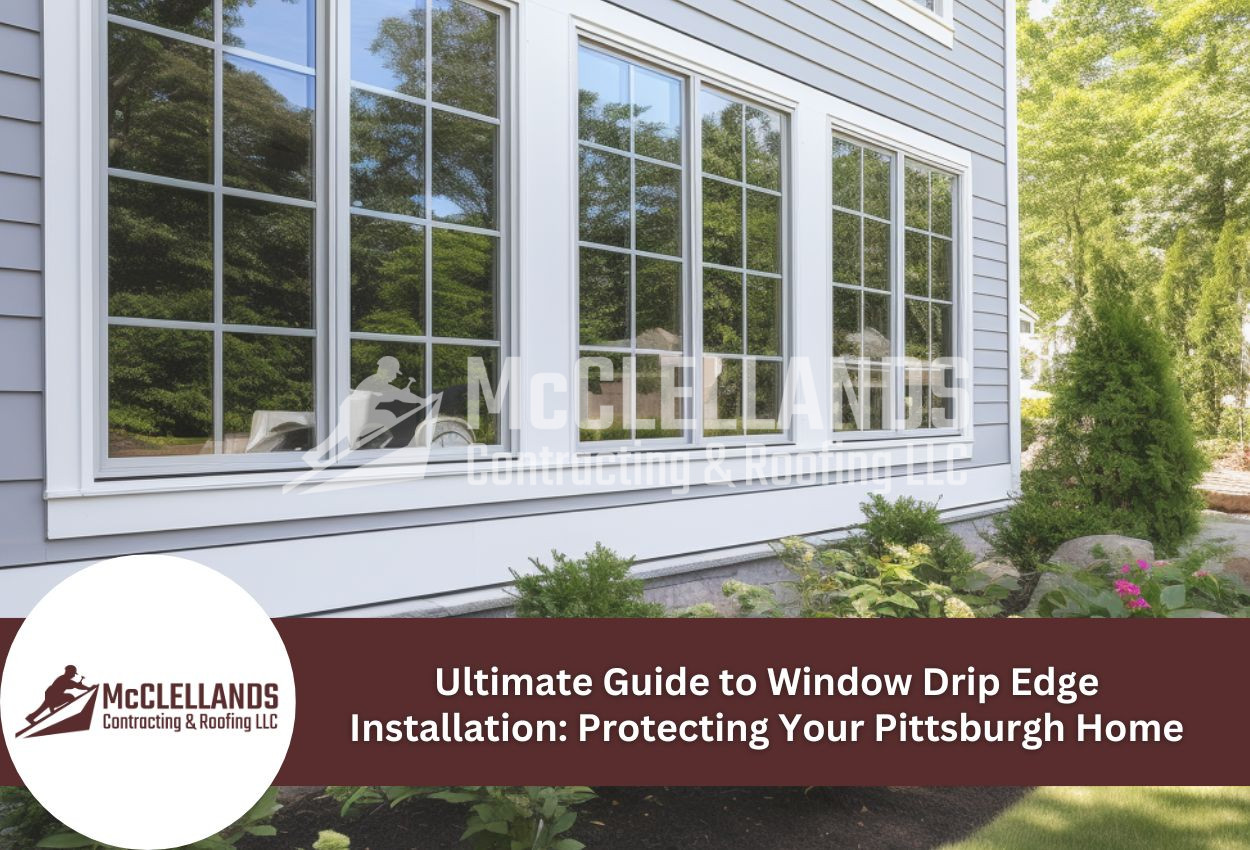Window drip edges have a big role in safeguarding Pittsburgh homes against the region's unpredictable weather patterns. These metal flashing components, sometimes also called drip caps, direct water away from window frames, preventing moisture infiltration that can lead to extensive structural damage over time. With Pittsburgh's annual rainfall exceeding 38 inches and winter precipitation regularly testing home exteriors, properly installed window drip edges are an essential defense against water damage.
Homeowners who invest in quality window drip edge installation enjoy multiple benefits beyond basic weather protection. The metal window drip edge flashing creates an effective barrier that prevents rot, mold growth, and deterioration of surrounding materials. This protection extends the lifespan of window frames while maintaining the integrity of adjacent siding and interior wall spaces.
Successful window drip cap installation requires understanding the right materials, tools, and techniques. From selecting metal flashing materials to positioning the components, each step contributes to the water-tight seal around window openings. The process involves careful measurement, precise cutting, and proper sealing techniques to ensure maximum protection against Pennsylvania's weather conditions.
This guide covers everything Pittsburgh homeowners need to know about installing window drip edges correctly, from preparation through completion, helping protect your home for years to come.
Understanding Window Drip Edge Flashing: Materials and Functions
Selecting the right materials for window drip edge flashing is crucial for Pittsburgh homes. Aluminum flashing offers lightweight durability and excellent corrosion resistance, making it popular for many home exterior applications. While more affordable, aluminum may not stand up to extreme weather as well as other options. Galvanized steel provides superior strength and durability, ideal for Pittsburgh's harsh winters, though it may require replacement sooner when protective coatings wear away. Copper flashing is a premium option with exceptional longevity, often lasting 50 years, and develops a patina over time that many homeowners like the look of.
The primary function of window drip edges is to create an effective water management system. When properly installed, these metal components form a physical barrier that intercepts rainwater flowing down exterior walls. The drip edge's shape forces water to drop away from the building rather than seeping behind siding or window frames. This simple principle prevents moisture infiltration that would otherwise lead to rot, mold growth, and deterioration of surrounding materials.
During Pittsburgh's freeze-thaw cycles, drip edges are even more important. They prevent ice dams from forming around windows and stop melting snow from seeping into vulnerable areas. By directing water away from the building, metal window drip edge flashing preserves structural integrity and extends the service life of your home's windows and surrounding areas.
Essential Tools and Materials for a Professional Installation
When preparing for window drip edge installation, start by gathering specific tools and materials to ensure a weathertight finish. Tools needed include a measuring tape (preferably 25-foot), quality tin snips for clean cuts through metal flashing, a cordless drill with appropriate bits, a level, and a caulk gun. Additional helpful tools include a rubber mallet, a utility knife with replacement blades, safety glasses, work gloves, and a pry bar for removing existing trim or flashing.
For materials, select high-grade metal flashing appropriate for our climate, such as aluminum, galvanized steel, or copper depending on your budget and home aesthetics. You'll need exterior-grade screws (preferably stainless steel to prevent rust), quality silicone caulk rated for exterior use, and butyl flashing tape. Consider adding drip edge corner pieces for a more finished look and better water protection at window corners.
Before installation begins, take accurate measurements of each window, adding 4 to 6 inches to each side for proper overlap. Inspect existing window frames for signs of water damage, rot, or mold that should be addressed before adding new flashing. Check that window frames are level and structurally sound. For older Pittsburgh homes, this assessment step is especially important as previous water infiltration may have caused hidden damage. Having replacement lumber on hand for minor repairs means you won't need to pause your project midway through installation.
Step-by-Step Window Drip Edge Installation Process
Installing window drip edges correctly requires attention to detail and following specific steps. Begin the process by removing any existing trim or deteriorated flashing around the window, being careful not to damage the surrounding siding or window frame. Clean the surface thoroughly, removing all debris, old caulking, and any loose material to create a smooth mounting surface for your new drip edge.
Next, measure the width of your window and add 4 to 6 inches of overhang on both sides. Cut your metal flashing to this length using tin snips, being careful to avoid jagged edges. For the top drip edge, create a bend along the length to ensure water will flow away from the window rather than against the house siding.
Position the drip edge above the window with the angled flange facing outward and upward. The flashing should tuck under the siding or building paper above the window but over the window frame itself. Secure the metal drip edge with stainless steel screws placed every 8 to 12 inches for maximum stability against Pittsburgh's strong winds and heavy precipitation.
Apply a continuous bead of exterior silicone caulk along the top edge where the flashing meets the siding to create a watertight seal. For maximum protection, install flashing tape over the upper edge, extending at least 2 inches onto the siding and drip edge. This creates a secondary moisture barrier that prevents water infiltration even during heavy downpours or when snow accumulates around windows.
Common Installation Challenges and Troubleshooting
Different housing architecture can present challenges when installing window drip edges. In older homes with uneven window frames or settled foundations, the standard installation approach often requires modification. When facing unlevel window openings, use shims to create a slight outward slope for the drip edge to ensure proper water drainage. For pre-existing water damage, remove and replace rotted wood completely before installation rather than covering it up, which would only conceal and worsen the underlying issue.
Additionally, different window types have specific approaches. Bay windows require custom-cut flashing pieces that maintain continuous coverage around corners. Historic wooden windows in Pittsburgh's century homes often need thinner profile drip edges to maintain architectural integrity while still providing protection. Vinyl replacement windows typically have built-in drainage channels that must align perfectly with your new drip edge installation.
Common installation problems include incorrect drainage angles that allow water to pool rather than drain away. If you notice this issue, remove and reinstall the flashing with a steeper angle. When securing flashing to various siding materials, remember that vinyl requires specialized mounting techniques that allow for expansion and contraction, while brick facades need masonry screws and appropriate sealants. Corner installations frequently leak if not correctly overlapped, so make sure to always work from bottom to top with each higher piece overlapping the lower one by at least 2 inches. For persistent leaks, apply a second layer of high-quality exterior silicone caulk along seams after testing with a garden hose.
Finishing Touches and Weather-Proofing Best Practices
Creating a completely weathertight window drip edge installation requires paying close attention to sealing details that many homeowners overlook. After securing your drip edge flashing, apply high-quality exterior silicone caulk along all seams where the drip edge meets the window frame and siding. Work with a steady hand to create a smooth, even seal without gaps or bubbles. For optimal results, use a caulk specifically rated for extreme temperature fluctuations and UV resistance.
Proper integration with your home's existing moisture management system is crucial for long-term protection. Apply self-adhesive flashing tape over the top edge of your drip cap, extending it at least 3 inches onto the house wrap or building paper. This creates a shingling effect that channels water downward and away from the window opening. When reinstalling siding, make sure pieces overlap the drip edge properly without restricting its water-shedding capabilities.
For homes with brick veneer or stucco exteriors, apply a compatible masonry sealant where the drip edge meets these materials. In particularly exposed locations on your Pittsburgh home, consider adding a secondary bead of caulk along the underside of the drip edge where it projects from the wall. This additional protection prevents wind-driven rain from being forced upward behind the flashing. Remember that comprehensive weather protection depends on your window drip edge working together with correctly installed siding, house wrap, and window flashing to create multiple layers of defense against moisture.
Maintaining Your Window Drip Edges for Long-Term Protection
A well-installed window drip edge requires regular maintenance to continue protecting your Pittsburgh home from water damage. Establishing a seasonal maintenance routine significantly extends the lifespan of your drip edges and prevents future repairs. In spring, inspect all window drip edges for winter damage, clearing away debris and checking for loose fasteners or separated seams. During summer, clean drip edges with mild soap and water to remove built-up dirt and pollen that could impede water flow. Fall maintenance should focus on clearing leaves and preparing for winter by ensuring all seals remain intact.
Watch for warning signs that indicate problems with your window drip edges. Visible rust or corrosion on metal flashing, peeling paint around windows, water stains on interior walls, or visible gaps between the drip edge and window frame all require immediate attention. Pittsburgh's freeze-thaw cycles can gradually loosen fasteners, so check for any movement or separation in the metal components during inspections.
Professional contractors recommend applying a protective silicone-based sealant to metal window drip edge flashing every 2 to 3 years to prevent corrosion. Before winter, ensure drip edges are clear of debris that could trap moisture and contribute to ice buildup. Address small issues promptly — a minor caulking repair can prevent substantial water damage to your window frames and surrounding wall structure. For older homes in Pittsburgh neighborhoods, upgrading to modern drip edge systems provides superior protection against our region's challenging weather conditions.
Expert Window Drip Edge Installation Services in Pittsburgh
Keeping your home protected against Pittsburgh's harsh weather conditions is crucial, and properly installed window drip edges are your first line of defense against water damage. McClellands Contracting and Roofing, LLC specializes in high-quality window drip edge installation, using the best materials suited for Pennsylvania's climate. Don't let improper installation compromise your home's integrity.
Ready to safeguard your home with professional window drip edge installation? Call McClellands Contracting and Roofing, LLC at (412) 353-5660 and ensure your home remains dry and damage-free. Reach out today to prevent future repairs and maintain your home's exterior.




